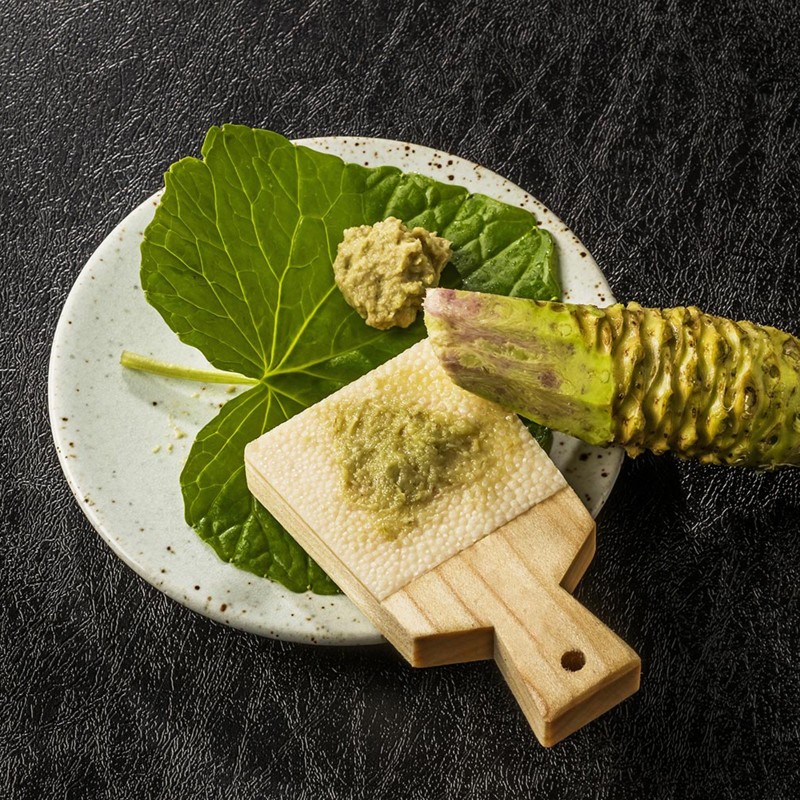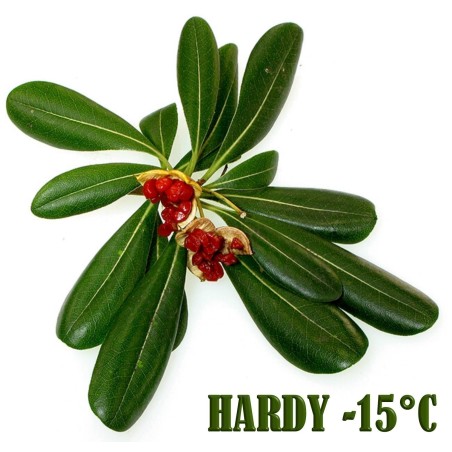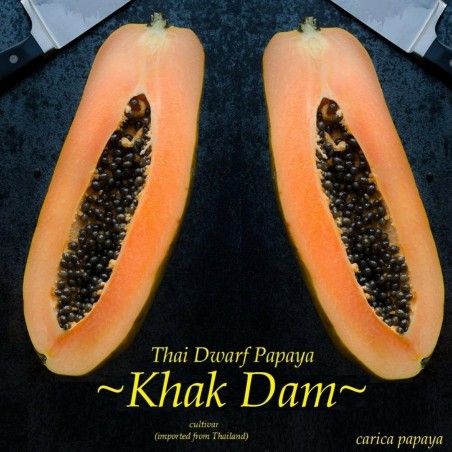
Wasabi Seeds (Wasabia japonica, Eutrema japonicum)
🪴 Semințe de Wasabi (Wasabia japonica / Eutrema japonicum)
💰 Preț: Pachet de 5 semințe
Wasabi (Wasabia japonica, cunoscut și ca Eutrema japonicum) este o plantă japoneză foarte apreciată din familia Brassicaceae, înrudită cu muștarul, hreanul și varza. Cunoscut ca hrean japonez, wasabi este faimos pentru aroma sa extrem de înțepătoare, producând vapori care stimulează mai mult pasajele nazale decât limba. Wasabi adevărat este rar în afara Japoniei din cauza condițiilor speciale de cultivare, care necesită apă rece și curgătoare de-a lungul râurilor de munte.
🍃 Aromă & Miros:
Gustul distinctiv al wasabiului vine de la izotiocianatul de alil, eliberat atunci când celulele tulpinii sunt zdrobite sau rase. Spre deosebire de senzația de arsură a ardeilor iuți, senzația de arsură este de scurtă durată, afectând în principal pasajele nazale. Wasabi proaspăt oferă o aromă înțepătoare, aromatică, ușor dulce și picantă, care nu poate fi replicată complet de înlocuitorii de hrean.
🍣 Utilizări culinare:
-
Sushi & Sashimi: Răzuit proaspăt și plasat între pește și orez pentru a păstra aroma.
-
Condimente & Sosuri: Folosit ca pastă, pudră sau răzuit proaspăt.
-
Gustări: Nuci, mazăre sau boabe de soia prăjite acoperite cu pudră de wasabi amestecată cu sare, zahăr sau ulei.
-
Frunze: Frunzele fragede sunt comestibile și ușor picante, folosite în salate sau ca decor.
💡 Cultivare și Creștere:
Wasabi este dificil de crescut, preferând medii umbrite, umede, cu temperaturi răcoroase. Semințele sunt delicate, iar cultivarea comercială este rară în afara Japoniei. Evitați achiziționarea semințelor de wasabi din surse neverificate, deoarece mulți vânzători, în special în China, pot trimite semințe de muștar sau alte semințe în loc de wasabi autentic.
🌱 Fapte interesante:
-
Wasabi a fost documentat în Japonia încă din anul 918 CE.
-
Vaporii săi înțepători au fost chiar studiați în cadrul unei cercetări câștigătoare a Premiului Ig Nobel pentru utilizarea în alarme de fum pentru surzi.
-
Wasabiul adevărat este verde în mod natural, în timp ce înlocuitorii sunt adesea făcuți din hrean, muștar și coloranți.
✨ Perfect pentru: Bucătari de sushi, entuziaști culinari, grădinari de plante medicinale și oricine dorește să experimenteze gustul autentic japonez din wasabi crescut acasă.


Aprecierea ta pentru recenzie nu a putut fi trimisa
Reclama un comentariu
Raport trimis
Reclamatia tau nu a putut fi trimisa
Scrie-ti recenzia
Recenzia a fost trimisa
Recenzia ta nu a putut fi trimisa
🌍 Livrare Globală din UE
Expediezăm la nivel mondial din Uniunea Europeană prin poștă recomandată cu confirmare de primire.
📦 Urmărirea coletului
Pentru a găsi numărul de urmărire, autentifică-te în cont și accesează Istoric comenzi > Detalii.
Urmărire globală: 17Track
Pentru numere de urmărire de forma RGxxxxxxHR: Posta.hr tracking
🕒 Notă: Informațiile de urmărire pot deveni disponibile până la 24 de ore după expediere.
⚠️ Observații importante
Plata ramburs nu este disponibilă.
Verifică-ți regulat folderul de spam/junk pentru notificări importante.
Toate întrebările trebuie adresate doar prin formularul de contact de pe site.
Mesajele trimise pe email direct pot să nu fie primite.
📱 Informații necesare la comandă
Te rugăm să introduci întotdeauna numărul tău de telefon mobil cu prefixul internațional.
Exemplu: +40 741 234 567
🚚 Politica de livrare
Coletelor recomandate li se solicită semnătură la primire.
Nu livrăm către:
cutii poștale
vecini
destinatari care nu sunt acasă pentru a prelua coletul
📬 Dacă adresa introdusă este o cutie poștală și coletul este pierdut sau nedisponibil, nu există drept la rambursare.
↩️ Returnări și reexpedieri
Dacă coletul ne este returnat:
Ești responsabil pentru taxa de returnare (2 €)
Și pentru costul reexpedierii
⏱ Întârzieri și urmărire colet
Dacă statusul de urmărire arată că pachetul este încă la expeditor, înseamnă că este în tranzit.
Contactează oficiul poștal local cu numărul de urmărire pentru informații.
Nu suntem serviciu poștal și nu putem urmări coletul în locul tău.
Nu răspundem pentru întârzierile de livrare.
🔍 Putem deschide o investigație pentru colete pierdute doar după 30 de zile de la data expedierii.
✈️ Opțiuni de livrare
| Tip livrare | Timp procesare | Asigurat | Posibile întârzieri | Observații |
|---|---|---|---|---|
| Standard | 7–10 zile lucrătoare | ❌ | 7–14 zile | Opțiune de bază |
| Prioritar | 1–7 zile lucrătoare | ❌ | 3–10 zile | Procesare prioritară, nu livrare mai rapidă |
| Asigurat | 1–7 zile lucrătoare | ✅ | 3–10 zile | Rambursare în caz de pierdere (până la 150 €) |
🕒 Estimare timp livrare:
În UE: 3–20 zile
Global: 5–30 zile
Exemple pentru SUA: 27, 22, 19, 17, 13 zile
💳 Modalități de plată
💶 Transfer bancar (SEPA / IBAN / SWIFT-BIC)
Introdu referința comenzii (ex. SGS-19811702) în descrierea plății.
Lipsa referinței poate duce la întârzieri sau anularea comenzii.
Comenzile se anulează automat dacă plata nu este primită în 7 zile.
🅿️ PayPal
Acceptăm doar plăți în euro (EUR) prin PayPal.
Te rugăm să schimbi moneda în Euro la plată.
💳 Plata cu cardul
Acceptăm: Visa, MasterCard, American Express, CB, Diners Club, Discover, China UnionPay, JCB și altele.
💡 Clientul suportă toate taxele de tranzacție. Te rugăm să ne trimiți detaliile plății pentru procesarea rapidă a comenzii.
📅 Alte informații
Comenzile nu sunt procesate și expediate în zilele de sâmbătă și duminică.
Te rugăm să consulți întotdeauna anunțurile importante de pe site înainte de plasarea comenzii (vacanțe, condiții speciale etc.).
📫 Pentru întrebări, folosește doar formularul de contact de pe site.
Mesajele trimise direct pe email nu vor fi procesate.
Related Products



















